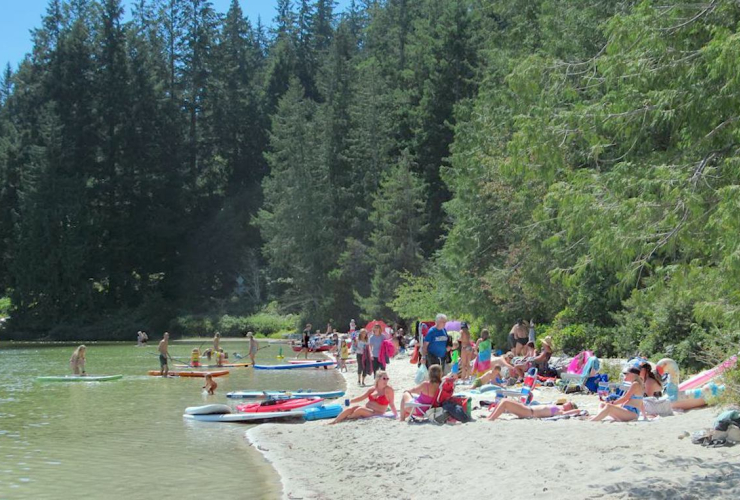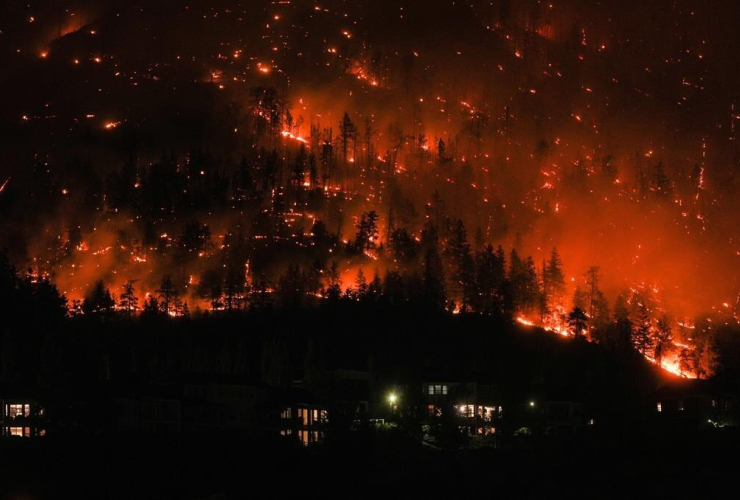What's the secret of a lush-looking lawn in Metro Vancouver, where watering is banned amid a brutal drought?
It might not be surreptitious sprinkling. Instead, it might be paint.
Tyler Basham, owner of Tinted Turf Grass Solutions, was giving a residential lawn in Maple Ridge an instant makeover on a recent morning, spray-painting the brown expanse and turning it a luxuriant green.
"I know it might sound a little silly at first, but then when you started looking at it and that kind of transformation from the start to finish, it's one of those phenomenal things," said Basham, wielding a spray wand and wearing a white plastic backpack filled with green paint.
Lawn watering was prohibited in Metro Vancouver's 23 local authority regions on Aug. 4, with the ban in place until Oct.15. Some homeowners are looking for alternatives including spray-painting or artificial turf, but others are embracing the golden look.
British Columbia is experiencing what the province calls a severe and unprecedented drought, with 29 of its 34 water basins at drought level 4 or 5, with level 5 being the worst level.
From May to July, just 54.6 millimetres of rain fell at Vancouver's airport, compared to the average 154.4 millimetres. August has been similarly dry so far.
The City of Port Coquitlam has launched a "golden lawn" contest, with residents being asked to submit photos of their "dormant" lawns to compete for $100 gift cards, all in the name of celebrating water conservation.
Chilliwack is staging a similar competition but isn't trying to gild the issue -- it says it wants to find the community's "ugliest lawn."
Port Coquitlam resident Kristi Hayward submitted a photo to her community's contest, showing her neighbour's dog on her parched and tufty lawn.
"It's just a way to make a fun thing out of something that was not fun," she said.
Port Coquitlam Mayor Brad West said he's sticking with his golden lawn, which he hasn't watered since Canada Day. He said the contest had been flooded with photo submissions.
Jackson Thornley, an owner of Turf Team Landscaping, said he's seen increased demand for his company's artificial grass in recent weeks.
"I think even last year, there was a little bit of a watering restriction towards the end of August, but this year has been a lot more, I would say, maybe a 20 per cent increase in demand for artificial grass now," said Thornley, adding that the company's waiting list was growing.
Thornley said installing artificial grass would typically save more than 50,000 litres of water per year for an average-size Vancouver yard.
Basham launched his lawn-painting business in June, and said business has picked up quickly. It costs about $200 to $250 to paint a typical residential lawn.
The watering restrictions are prompting many homeowners to seek alternatives, he said.
"People like to have green grass … and people care about their properties. We live in a really nice part of the world, and people like to make their yards look nice," he said.
The process of lawn painting, long popular in California, is similar to hair dyeing, said Basham. He said he consults with homeowners to choose the appropriate shade of green.
He said the paint is long-lasting, at least until the grass grows out again and the painted tips are mowed.
"It's a permanent paint, one rain is not gonna hurt (it)," said Basham.
It's also biodegradable and environmentally friendly, he said. "I have two young kids. One is two, one is three months and I have our grass painted. I've got a dog as well," said Basham. "I wanted to make sure (and) I wouldn't put it in my yard if I didn't believe the product."
Basham said lawn painting is popular among real estate agents staging properties for sale.
Real estate agent Justine Williams, one of Basham's clients, said agents want properties to be "perfect-looking and show-ready."
Williams said she had her own lawn painted before recommending it to clients.
"I had it done probably about a month ago and it still looks the same as it did the day I got it painted," she said.
This report by The Canadian Press was first published Aug. 29, 2023.
How quaint. Like painting a
How quaint. Like painting a landscape on your windows to cover up the smoke.
Why is this news-worthy?
The day will come where like
The day will come where like in other places like Perth Australia, if you want a green lawn, you put in artificial turf or alternately, landscape using stone as done in Arizonia. Climate change is here and not much will return to normal at this point, but if anything will only get worse.
Painting lawns is ridiculous and question how environmentally sound this truly is and not only that, likely does a lot of harm to grass that is left.
So, in BC, it has been drought, whereas in southern Ontario, we have had a wet summer for the most part. The lawn is so green, which is unusual for this time of year, that I can't keep it cut fast enough each week. With climate change, next summer it could be the total opposite, who knows, just expect things to get worse one way or another.
Grass has to be dried out for
Grass has to be dried out for a long, long time before its roots all die. No color of paint will help that.
I'd also wonder what kind of dye is being used.
As far as astro-turf goes, how is *that* not a "single use" plastic? And for sure, it is not biodegradable.
Real Estate people who show properties like that should probably be charged with fraud.
But isn't it typical, that what something "looks like" is more important to people than what actually *is*.
That, and the ridiculous focus on entertainment as a reason for living, are among the most terrible changes in social behaviour during my lifetime.
The rhizome of grass species
The rhizome of grass species is below ground. The grass lays dormant in dry weather as a survival mechanism, just as trees lose their leaves when under stress. Grass doesn't die until the soil is dead and the moisture deep below the roots disappears. Ornamental perennial grasses noted by their thin leaves (less surface area to dry out) can be chosen for their exemplary drought tolerant characteristics. Some desert grasses have roots that penetrate metres deep into the ground.
Suburban lawns are a biological desert and consist mainly of one or two thirsty Kentucky Blue varieties with a few other types added. When Metro Vancouver first enacted watering restrictions they discovered lawns consumed over 40%of the expensive public potable drinking water supply in summer merely to keep them green. It remains at about 20% which is still ridiculous considering the three rain and snow-fed mountain reservoirs are major pieces of publicly funded infrastructure.
In my view painting lawns is a non-story that only illuminates the story that we need to do things much better, like plan for rainwater harvesting over the winter months when several hundred thousand litres of water falls on those enormous suburban roofs. Storing the rainwater in 5,000+ litre underground cisterns is perfectly suited for the average single family lot for summer use for lawns and gardens, and it should be expanded to entire neighbourhoods and the wider city.
Metro Vancouver has a very large storm water sewer system (combined with sanitary sewers in older areas) for a reason. In fact, they are spending billions over decades to enlarge the system to accommodate climate-related higher average seasonal rainfall levels and more intense storms. The rain falling off millions of square metres of roofs and roads could be harvested to provide non-potable water for fire fighting, the irrigation of parkland and some industrial processes that don't require drinkable water.
Potable water is currently pumped from the mountain lakes to large reinforced concrete cisterns in various higher elevation urban locations (e.g. parks) for gravity-assisted distribution to local homes and businesses through the water pipe network. The same technique could apply to storing non-potable water from street drains and roof gutters, and could be expanded to to collect grey water from sinks and tubs in buildings, run it though filters then mix it with collected storm water, then distribute it through a parallel network built at the most advantageous and least disruptive time when major upgrades to streets and utilities are already planned.
Houses and businesses would have two metered supply lines with higher rates applied to the potable supply. There is no reason why fire suppression systems like indoor ceiling sprinklers and street hydrants couldn't use non-potable water to conserve fresh water in a warming world. And there is no reason why a lawn or ornamental planting bed needs to consume precious drinking water.




Comments